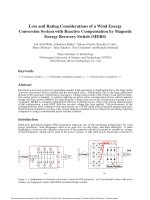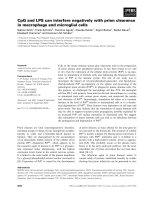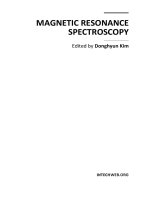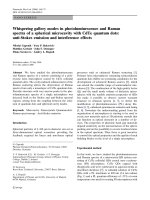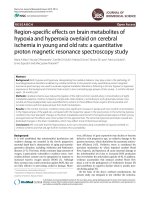Magnetic resonance spectroscopy correlation with histological analysis in gliomas and structure determination of a hypothetical protein
Bạn đang xem bản rút gọn của tài liệu. Xem và tải ngay bản đầy đủ của tài liệu tại đây (1.54 MB, 92 trang )
Magnetic resonance spectroscopy correlation with
histological analysis in gliomas and structure determination
of a hypothetical protein
Xu Ying
National University of Singapore
2004
Magnetic resonance spectroscopy correlation with
histological analysis in gliomas and structure determination
of a hypothetical protein
Xu Ying
A THESIS SUBMITTED FOR THE DEGREE OF
MASTER OF SCIENCE
CHEMISTRY DEPARTMENT
NATIONAL UNIVERSITY OF SINGAPORE
2004
ACKNOWLEDGEMENTS
I would like to thank my supervisor, assistant professor Yang Daiwen for his
encouragement, patience and guidance during the course of my research project.
I would like to thank Dr. Lim Tchoyoson from National Neuroscience Institute
(Singapore) for providing brain tissue samples.
Special thanks go out to Mr. Li Kai and Mr. Zheng Yu for their useful scripts,
Mr. Xu Xingfu and Mr. Lin Zhi for their kindly help on protein structure project.
Many thanks to post-doctors and students from NMR structural biological lab and my
friends in Department of Chemistry and other department or institutes, who made my
stay in NUS a pleasant and memorable journey.
Finally, I wish to thank the National University of Singapore for granting me a
Research Scholarship.
i
Contents
Acknowledgements
i
Contents
ii
Summary
iv
List of figures
vi
List of tables
viii
Symbols and abbreviations
ix
1 Introduction
1
1.1 Introduction to brain metabolites studies
2
1.2 Introduction to NMR structural studies of proteins
11
1.3 Objective
19
1.3.1 Objective of brain metabolites study
19
1.3.2 Objective of NMR structural studies of protein ec314
19
2 NMR studies of brain metabolites
20
2.1 Materials and methods
20
2.1.1 Sample preparation
20
2.1.2 NMR experiments
20
1
20
2.1.2.1 1D HRMAS HMRS experiment
1
13
21
2.1.2.2 2D H- C HSQC experiment
1
1
21
2.1.2.3 2D H- H COSY experiment
2.1.3 Chemical shift database
21
2.1.4 Quantitative analysis of brain metabolites
23
1
24
2.1.4.1 HRMAS HMRS
2.1.4.2 Matlab program
25
2.1.4.3 Curve fitting and calculating
28
2.2 Results and discussion
31
2.2.1 Identification of brain metabolites
31
2.2.2 Quantitative analysis of metabolites
40
2.3 Conclusion
44
3 NMR structural studies on protein ec314
45
3.1 Materials and methods
45
3.1.1 NMR experiments
45
1
15
45
3.1.1.1 2D H- N HSQC spectrum
3.1.1.2 HNCACB and CBCA (CO) NH
45
3.1.1.3 C (CO) NH and H (CCO) NH
47
3.1.1.4 HCCH-TOCSY
49
15
13
49
3.1.1.5 N edited NOESY and C edited NOESY
3.1.2 Chemical shift assignment
52
3.1.2.1 Backbone sequential assignment
52
3.1.2.2 Aliphatic side chain assignment
52
3.1.3 Secondary structure
53
3.1.3.1 Chemical shift index prediction
53
3.1.3.2 Sequential NOE pattern and short, medium-range NOE analysis
ii
3.1.4 NOE assignment of 15N edited NOESY and 13C edited NOESY
3.1.5 Structure calculation
3.1.5.1 NOE restraints
3.1.5.2 Dihedral angle restraints
3.1.5.3 Hydrogen bond restraints
3.1.5.4 Structure calculation
3.2 Results
3.2.1 Backbone assignment and aliphatic side chain assignment
3.2.1.1 Backbone assignment
3.2.1.2 Aliphatic side chain assignment
3.2.2 Secondary structure
3.2.2.1 Chemical Shift Index
3.2.2.2 NOE analysis
3.2.3 NOE assignments
3.2.4 Structural statistics
3.3 Discussion
3.3.1 Sequential assignment and secondary structure prediction
3.3.2 Description of structure of protein ec314
3.3.3 Helix regions
3.3.4 Proline conformation
3.3.5 Unstructured region and loops
3.3.6 Comparison to similar structures
Conclusion and future work
Reference
53
54
54
54
55
55
56
56
56
59
61
61
63
64
64
65
65
66
68
68
68
68
71
73
iii
Summary
Human and mouse brain tissues obtained through National Neuroscience
Institute (Singapore) were submitted to record 1D HRMAS 1H NMR and 2D 1H-1H
COSY and 1H-13C HSQC spectra. Using 2D COSY and HSQC spectra to identify
metabolites, comparing two human brain samples, three significant differences were
observed. It suggests the possibility of differentiating brain tumors by analyzing
metabolites using NMR technique.
1D HRMAS 1H NMR spectra of both human and mouse brain tissue were
used to calculate the concentration of major brain metabolites. The absolute amounts
of 7 major metabolites in each sample were calculated for 20 brain tissues. New
method using Matlab program to fit the curves of metabolites was demonstrated.
HRMAS 1H NMR technique has been proved that it is suitable for quantitative
analysis of brain tissues. Furthermore the calculation becomes straightforward by
using Matlab.
To determine the 3D structures of protein ec314, various 2D and 3D NMR
spectra were recorded. Using 2D
1
H-15N HSQC spectrum as reference, 3D
hetero-nuclear experiments HNCACB and CACB(CO)NH were combined to
sequentially assign backbone atoms. Aliphatic side chain carbon and proton spin
system were assigned and connected to the sequentially assigned backbone
resonances by using C(CO)NH, H(CCO)NH and HCCH-TOSCY spectral. Chemical
Shift Index and NOE patterns were used to identify secondary structures.
The 3D structure of protein ec314 was calculated using NOE restraints,
iv
hydrogen bond restraints and dihedral angle restraints. The final structure shows
ec314 is composed by 3 helices. It is similar to the C-terminal domain of E. coli RecA
protein.
v
List of Figures
Figure 2.1
HRMAS 1HMRS spectrum of brain metabolites
24
Figure 2.2
Matlab program
27
Figure 2.3
Result of curve simulation by Matlab
29
Figure 2.4A
COSY spectrum of human brain tissue sample NNI1
32
Figure 2.4B
HSQC spectrum of human brain tissue sample NNI1
34
Figure 2.5A
COSY spectrum of human brain tissue sample NNI2
36
Figure 2.5B
HSQC spectrum of human brain tissue sample NNI2
37
Figure 3.1
Schematic show of coherence transfer pathways employed and
46
the correlations made in CBCA(CO)NH and HNCACB
experiments.
Figure 3.2
Overlook of NOESYCN spectrum
51
Figure 3.3
TCL script for conversion between 13C and 15N chemical shifts
51
Figure 3.4
CACB connectivity from CBCA(CO)NH (①) and HNCACB
57
(②) for a stretch of residues from E24 to G29
Figure 3.5
The 1H-15N HSQC spectrum of 15N labeled ec314
58
Figure 3.6
Aliphatic side chain assignments
60
Figure 3.7
Selected
1
H(F3) and
1
H(F1) planes at different
13
C(F2)
61
chemical shifts of the HCCH-TOCSY spectrum illustrating
connectivity
vi
Figure 3.8
13
62
Figure 3.9
The secondary structure analysis based on short- and
63
Cα-Cβ Chemical Shift Index plot of ec314
medium-range NOEs
Figure 3.10
Stereo-view of the superposition of backbone atoms for 20
66
structures
Figure 3.11
Ribbon diagram representation of 3D structure of protein
67
ec314
Figure 3.12
Ribbon diagram representation of 3D structure of protein
70
RecA
vii
List of Tables
Table 2.1
Chemical shift table of metabolites
23
Table 2.2
Structure formula and total proton numbers of TSP and
30
metabolites
Table 2.3a
Amount of metabolites of mouse brain tissues
41
Table 2.3b
Amount of metabolites of human brain tissues submitted on 27th
41
March
Table 2.3c
Amount of metabolites of human brain tissues submitted on 31st
42
March
Table 2.3d
Amount of metabolites of human brain tissues submitted on 19th
42
May
Table 3.1
Summary of the restraints used to calculate the structures
64
Table 3.2
Structural statistics for the CYANA calculation and final
65
ensemble
viii
Symbols and abbreviations
1D
One-dimensional
2D
Two-dimensional
3D
Three-dimensional
COSY
Correlated spectroscopy
ec314
Name of the protein
HMBC
Hetero-nuclear multiple bond correlation
HRMAS
High-resolution magic angle spinning
HSQC
Hetero-nuclear single quantum correlation spectrum
M
Molar
ml
Milliliter
mm
Millimeter
ppm
Parts per million
rpm
Rounds per minute
µl
Micro liter
MRS
Nuclear magnetic resonance spectroscopy
NMR
Nuclear magnetic resonance
NOE
Nuclear Overhauser effect
NOESY
Nuclear Overhauser enhanced spectroscopy
RMSD
Root-mean-square deviation
TOCSY
Total correlation spectroscopy
ix
TROSY
Transverse relaxation-optimized spectroscopy
TSP
3-(trimethylsilyl) propionate sodium salt
Ala, A
Alanine
Arg, R
Arginine
Asn, N
Asparagines
Asp, D
Aspartic acid
Cys, C
Cysteine
Glu, G
glycine
His, H
Histidine
Ile, I
Isoleucine
Leu, L
Leucine
Lys, K
Lysine
Met, M
Methionine
Phe, F
Phenylalanine
Pro, P
Proline
Ser, S
Serine
Thr, T
Threonine
Trp, W
Tryptophan
Tyr, Y
Tyrosine
Val, V
Valine
x
1. Introduction
1.1 Introduction to brain metabolites studies
Nuclear magnetic resonance phenomenon was first detected by Bloch and
Purcell independently in 1946 (Bloch, 1946; Purcell, 1946). They found that when
certain nuclei were placed in a magnetic field and is subjected to radiofrequency at the
appropriate frequency, they absorbed the energy and re-emitted this energy when
transition of the nuclei from high energy level to their original state. The energy
absorbed by the nuclear spins induces a voltage that can be detected by a suitably
tuned coil of wire, amplified and then the signal displayed as free induction decay.
The most important fundamental parameter in NMR spectroscopy is chemical
shift firstly observed by Knight in 1949 (Knight, 1949). It is defined as the nuclear
shielding divided by the applied field and depends only on the sample conditions
(solvent, concentration, temperature) and not on the spectrometer frequency, which
means in NMR spectroscopy, each nucleus gives rise to a resonance which is
characterized by chemical shift reflecting its unique chemical environment. Thus
chemical shift becomes an important parameter for identifying individual nucleus and
assigning the resonance in the spectra to its corresponding site in chemical structure.
NMR spectroscopy was firstly used for structural determination of small
molecules in organic chemistry. Afterwards with the rapid development of NMR
technique, NMR has been widely used in many different fields such as clinical
research, macromolecule characterization. At the beginning of the 1980s, while NMR
imaging became clinically feasible, after its introduction in the 1970s, whole-body
1
magnets of adequate field strength and homogeneity were constructed. Almost at the
same period, NMR techniques suitable for in vivo studies were developed (Burtscher,
2001).
Today, nuclear magnetic resonance spectroscopy (MRS abbreviated by clinical
researchers) has been widely used in clinical research as a unique tool for providing
noninvasive access and measurements of important endogenous metabolically active
compounds throughout the body, including the brain (Akihiro, 2000). Theoretically,
almost all tissues and organs studied by NMR imaging can be studied by proton-MRS.
However, the brain has by tradition been one of the organs most studied by in vivo
1
H-MRS, mainly due to its well-suited MRS properties. The brain is the organ in
which functional differentiation among regions is most advanced. It is, moreover, one
of the tissues of the body that exhibits very high levels of metabolism. Therefore
physiologic and biochemical information concerning the kinetics and metabolism of
substances as well as anatomical and morphological information must be evaluated
for clarification of normal functions of the brain and clinical diagnosis.
An advantageous property of NMR that plays an important role in medical
applications is the low energy of the radio frequency quanta used (Hausser, 1991).
Even with the highest magnetic fields applied nowadays, their energy of about
4*10-25J is considerably below the energies required to crack a covalent chemical
bond, with typical bond energies of the order of 10-17 J. Hence, NMR is a
non-destructive method in contrast to other methods that use ionizing radiation.
Due to its high sensitivity and ability to detect numerous tissue metabolites,
2
proton MRS has become well established as a non-invasive technique for studies of
biological systems in vivo and in vitro. Quantitation of the NMR-observable
metabolites can provide considerable biochemical information, and can help clinical
investigators in understanding the role of metabolites in normal and pathological
conditions. In recent years the biomedical and in vivo applications of 1H spectroscopy
have increased, in part due to the increased availability of high magnetic field
strengths and improved spectrometer performance.
Applying magic-angle spinning (MAS) in proton MRS can reduce the spectral
line-widths significantly. In liquids, molecules do not experience significant motion
restriction and tumble at rates faster than the NMR time scale. Thus, spectral
broadening effects due to molecular interactions are averaged, resulting in narrow
spectral lines. In tissues, restriction of molecular motions and magnetic susceptibility
results in spectral broadening that is not effectively averaged. As a consequence,
tissues may be considered to have certain characteristics of solid molecular
interactions. In solids, interactions such as dipole couplings and chemical shift
anisotropy produce spectral broadening with an angular dependence of (3cos2θ-1),
where θ is the magic angle and equal to 54.7°. When the sample was rotated around
an axis at a magic-angle 54.7° with respect to the static field direction, the line-widths
of the spectra reduced dramatically (Cheng, 1997). Currently, MAS is applied
routinely in most high-resolution solid-state NMR experiments, and spinning
frequencies continue to increase dramatically with increasing B0.
As a biochemistry-based and quantitative method, high-resolution solid state
3
magic-angle spinning proton MRS (HRMAS 1HMRS) is suitable as a tool for
experimental and clinical neuron-pathologic investigations. The significant advantage
of HRMAS 1HMRS is that it’s rapid, nondestructive and requires only small amounts
of unprocessed samples. Unlike chemical extraction or other forms of tissue
processing, this method analyzes tissue directly, thus minimizing artifacts.
One difficulty associated with in vivo proton spectroscopy is the identification
and the measurement of individual metabolite contributions in spectra (Govindaraju,
2000). This is largely due to the presence of numerous unresolved multiplet groups
exhibiting complex line shapes and considerable spectral overlap, which is
particularly severe at the lower B0 field strengths that are commonly available for
studies in humans. Along with the application of 2D 1H-13C HSQC spectrum, the
problem of overlap has been resolved. HSQC spectrum allows one to assign both
proton and carbon chemical shift of the metabolites, thus most metabolites can be
assigned unambiguously.
Additional difficulties are caused by variable spectral patterns caused by
susceptibility-induced line-shape distortions, the presence of broad uncharacterized
resonances from macromolecules, lipids and unsuppressed water, and low
signal-to-noise ratios. The analysis of such data is greatly facilitated by incorporating
priori spectral information in a parametric modeling approach.
Chemical shift and signal intensity are suitable for identification and
quantitation of singlet resonances observed at any field strength. For compounds
having multiple resonances, additional priori information is available in terms of fixed
4
frequency separations and relative amplitudes of the individual resonances belonging
to each compound. However, unless some form of spectral-editing acquisition method
is used to obtain a simplified spectrum, additional care is required for the analysis of
compounds exhibiting multiplet resonances from spin-coupled nuclei. For these cases,
identification using individual resonance frequencies is not only strongly field
dependent, but also requires information on the phase of the individual resonances,
which may be altered when using multiple-pulse spatial localization sequences.
Due to higher sensitivity and better signal separation inverse correlated 2D-1H,
13
C NMR experiment offers much more information compared to standard proton or
13
C spectra. It correlates proton and attached carbon atom to provide both 1H and 13C
chemical shifts of each group within a compound. Therefore 2D experiments are more
powerful for identification of metabolites.
The development of more advanced MRS sequences and their implementation
by clinical MR units have made it possible to obtain proton spectra from brain tumors
in the course of a clinical MRI examination and this has increased acceptance of MRS
as a possible diagnostic tool. Furthermore the application of 2D hetero-nuclear NMR
experiment improves the preciseness of the characterization of brain metabolites.
The spatial distribution of key energy metabolites, such as adenosine
triphosphate (ATP), phophorylated and unphosphorylated creatine, lactate, glucose,
glycogen and fatty acid energy reserves, and compounds associated with neuronal
function including glutamate, glutamine, γ-aminobutyric acid (GABA), and
N-acetylaspartate, a putative neuronal maker, are all currently observable via
5
phosphorus (31P), hydrogen (1H), and carbon (13C) MRS. In addition to measuring the
static levels of these compounds, dynamic measurements of metabolic flux and
response to stimuli are observable by monitoring reactants and products by MRS
(Akihiro, 2000). Thus, to the extent that these substances and parameters play key
roles in brain function, the advent of spatially localized MRS opens a potential
flood-gate of rich information about normal and disease process involving these
substances. MRS is a fundamentally new method of probing brain function.
In brain metabolite studies by NMR spectroscopy, selected compounds are
low molecular weight and may be present with effective proton concentrations of
approximately 0.5mmol per kg of wet weight (kgww) or higher, either in normal brain
or following increases with disease (Varanavasi, 2000). And only L-amino acids are
considered. Measurement of NMR parameters is limited to conditions of normal brain
pH and temperature, while identifying those molecular groups for which pH or
temperature dependent changes may be expected over a physiologically relevant
range. Most studied metabolites in brain are Acetate, N-Acetyl aspartate (NAA),
N-Acetylaspartylglutamate (NAAG), Alanine, Choline, Creatine, Glutamate, Glycine,
Myo-inositol, Lactate, Pyruvate, Serine, Threonine, Tyrosine and Valine.
Acetate is an essential building block for synthesis of a number of compounds.
Its presence has been reported in several cell cultures and extracts, though its
abundance was questioned as a possible artifact of the sample preparation. Acetate
concentrations in human brain were observed to increase in brain tumors, ischemia,
and in vivo in brain abscesses (Martin, 1994). Acetate is a simple molecule containing
6
a single CH3 group that provides a singlet at 1.90 ppm, which is shifted downfield at
lower pH.
NAA was found in the central nervous system of vertebrates in high
concentration by Tallan et al. in 1956. NAA is thought of as a marker of
neuronal/axonal density and viability (Birken, 1989). Although knowledge of its
functional role is limited, loss of or decrease in NAA is generally seen in diseases
associated with loss of neurons or axonal injury. NAA has seven protons that give
NMR signals between 2.0 and 8.0 ppm. It typically provides the most prominent
resonance, a singlet at 2.01 ppm, from the three protons of an N-acetyl CH3 group. In
1D in vivo spectrum at lower field strengths, this resonance may also contain smaller
contributions from NAAG, though this can be separated at higher field strengths or by
using 2D methods. NAA also has three doublet-of-doublets centered at 2.49, 2.67 and
4.38 ppm that correspond to the protons of aspartate CH2 and CH groups.
Alanine, a nonessential amino acid that contains a methyl group, is present in
the human brain at approximately 0.5mmol/kgww (Provencher, 1993). Increased
alanine has been observed in vivo in meningiomas and following ischemia. The CH3
and CH protons of alanine form a weakly coupled AX3 system with a doublet at 1.47
ppm and a quartet at 3.77 ppm.
Choline is an essential nutrient that is mainly obtained in the form of
phospholipids from the diet. It is required for synthesis of the neurotransmitter
acetylcholine, and of phosphatidylchoine, a major constituent of membranes (Pouwels,
1998). For MRS studies on tissues, the choline signal is primarily observed as a
7
singlet at 3.2ppm that includes contributions from free choline, glycerol-phosphoryl
choline (GPC), and phosphoryl choline (PC), and it is often referred to as ‘total
choline’. The total NMR observable choline concentration in human brain is
approximately 1-2mmol/kgww, and known to be non-uniformly distributed.
Creatine and phosphocreatine (PCr) are present in brain, muscle, and blood.
The synthesis of creatine takes place in the kidney and liver. It is reduced in the brain
of patients with brain tumor or infectious brain masses (Wang, 1998). In vivo NMR
measurements in brain observe the total of both creatine and phosphocreatine as
prominent singlet resonance from their methyl-protons, at 3.03 ppm.
Glutamate is the most abundant amino acid found in human brain at a
concentration of approximately 12mmol/kgww. It is known to act as an excitatory
neurotransmitter, although believed to have other functions (Ross, 1991). The signal
from the single proton of the methine group is spread over as a doublet-of-doublets
centered at 3.74 ppm.
Of the nine isomers of inositol (Cerdan, 1985), myo-inositol is the
predominate form found in tissue. The function of myo-inositol is not well understood,
although it is believed to be an essential requirement for cell growth, an osmolite, and
a storage form for glucose. Normal concentrations range from 4 to 8mmol/kgww, and
altered levels have been associated with Alzheimer’s disease, hepatic encephalopathy
and brain injury. This compound gives four groups of resonances. A
doublet-of-doublet centered at 3.52 ppm and a triplet at 3.61 ppm are the two
prominent mutliplets each corresponding to two protons. A triplet at 3.27 ppm is
8
typically hidden under choline, and another at 4.05 ppm is typically not observed
because of water suppression.
Lactate is the end product of anaerobic glycolysis, normally present in brain
tissue at low concentrations and therefore generally not observed by in vivo MRS
studies. Brain lactate is a marker for inadequate oxygen supply to tissues. Its
concentration in brain tissues increases when oxygen is deficient or energy
requirement increases, and when irreversible damage is caused by persistence of
pathological conditions. The methyl and methane groups of lactate form an A3X spin
system and detection is commonly carried out via the doublet from the methyl group,
at 1.31 ppm.
Intracranial neoplasms, brain tumors, have extensively been studied with in
vitro and in vivo MRS (Burtscher, 2001). It has been shown that spectral patterns
revealed by MRS in tumor tissue differ from those of normal brain. Spectral changes
often shown in brain tumors are the increase in choline, decrease in or absence of
NAA and the presence of lactate or lipids. Recent reports support that MRS can be
useful in clinical practice for differentiating between certain brain tumors, based on
changes in metabolite ratios across the lesion and the surrounding tissue. The changes
of lactate/AA ratio from varies type of brain abscesses make it possible to
differentiate anaerobic from aerobic or sterile brain abscesses on the basis of
metabolite patterns observed at in vivo proton MR spectroscopy. Clinical research
also found that an excellent correlation between neuronal loss shown by traditional
neuron-histopathology and decrease of neuronal marker NAA measured by proton
9
MRS.
Recent researches support that 1HMRS can be useful in clinical practice for
differentiating between certain brain tumors, based on changes in metabolite ratios
across the lesion and the surrounding tissue (Cheng, 1997). It has been shown that
spectral patterns revealed by MRS in tumor tissue differ from those of normal brain.
Spectral changes often shown in brain tumors are increase in choline, decrease in or
absence of NAA and the presence of Lactate or lipids. An excellent correlation
between regional neuron loss and regional NAA decrease was found. Furthermore, the
disappearance of the metabolites of bacterial origin after aspiration observed by
comparing NMR spectrum before and after therapy suggests a positive response to
combined therapy.
Recent years the incident of brain diseases varies from 1 to 2% in developed
countries to 8% in developing countries. With the emergence of acquired
immunodeficiency syndrome the incidence of brain abscesses is on the increase
worldwide (Dev, 1998). It may be the most important thing in clinical medicine to
detect and diagnose type of brain diseases at the beginning. The more efficient and
accurate the diagnosis is made, the higher the possibility for the patient to be cured.
Therefore it is significant to discover a new method for early detection and diagnosis
of brain diseases.
In our study, both 2D HSQC and COSY experiments have been done for
identification of metabolites. Furthermore, the HRMAS 1HMRS experiment has been
done. By fitting the curves of HRMAS 1HMRS using Matlab program, the exact
10
concentrations of major brain metabolites can be calculated. By analyzing
combination of several NMR spectra, the differences in metabolites and their
concentrations in brain can be observed. Based on these differences, brain tumor
metabolites may become new evidence to differentiate brain tumors.
1.2 Introduction to NMR structural studies of proteins
NMR spectroscopy and X-ray crystallography currently are the only two
techniques capable of determining the three dimensional molecular structure of
protein at atomic resolution. NMR measurements are carried out in solution under
natural physiological conditions, whereas X-ray crystallography requires single
crystal. Furthermore NMR spectroscopy can investigate time-dependent phenomena,
including reaction kinetics and intra-molecular dynamics of macromolecules.
Additionally, NMR is efficient in determining ligand binding and mapping interaction
surfaces of protein/ligand complexes.
Since first three-dimensional protein solution structure was solved in 1980’s
(Wüthrich, 1986), numerous protein structures have been solved by NMR and
important protein functions have been revealed by protein dynamic studies.
Nowadays, with routine NMR techniques, NMR spectroscopy can be applied to
determine structures of proteins with medium or large size. This achievement depends
on the rapid developments in various areas. With the development of high-field
superconducting magnets and improvement in radiofrequency electronic and NMR
probe design, high resolution spectra can be obtained and sophisticated pulse
11
sequences can be applied. At the same time, advanced computers and workstations are
capable of controlling experiments and various powerful softwares make it easier and
faster to analyze spectra. Furthermore, multidimensional multinuclear techniques have
overcome the problem of overlap caused by the large number of protons in a protein.
Last but not least, with the improvement of understanding of fundamental NMR
parameters, new NMR experiments are to be designed and more accurate structural
information can be obtained (Reid, 1997). Both instrumental and methodological
methods of NMR are in a continually evolving process and NMR will become even
more powerful in protein structural and functional studies.
When the first protein solution structure was solved at 1986 by Wüthrich
(Wüthrich, 1986), the sequential resonance assignment was done using several 2D
NMR experiments. Conventional sequential resonance assignment of small proteins
relies on 2D COSY and TOCSY spectra to identify the residue type of each spin
systems, and 2D 1H-1H NOE experiments to identify sequential connections along the
backbone. Finally, comparison of the connected peptide information to known protein
sequence will yield sequence-specific resonance assignment. With increasing protein
molecular weight, 2D experiments are no longer sufficient to solve the problem of
spectral complexity due to resonances overlap. This barrier can be overcame with
multidimensional hetero-nuclear NMR techniques and uniformly 13C and 15N labeled
proteins. Furthermore, applying deuteration technique to replace protons will
dramatically reduce the line widths therefore facilitate the assignment of backbone
and side chain carbon for proteins larger than 25kDa.
12
The introduction of 3D and 4D hetero-nuclear NMR experiments and the
availability of uniformly
15
N -13C labeled samples allow one to assign proton,
nitrogen and carbon chemical shifts of proteins and protein complexes with molecular
weight above 25 kDa and to determine their structures in solution (Clore and
Gronenborn, 2000). Peak overlapping will be reduced evidently by using
hetero-nuclear correlation experiments because of resonance spreading into an
additional dimension. These experiments used are highly selective for correlations of
three spins (1H,
13
C,
15
N), which significantly simplify the identification of atoms
involved in correlations. Additionally, it places much less dependency on NOE
connectivity, which may be ambiguous in larger proteins.
The main source of geometric information used in protein structure
determination lies in the nuclear Overhauser effect (NOE), which can be used to
identify protons separated by less than 5Å. This distance limit arises from the fact that
the NOE is proportional to the inverse-sixth power of the distance between protons.
Hence, the NOE intensity falls off very rapidly with increasing distance between
proton pairs. The nuclei involved in the NOE correlation can belong to amino acid
residues that may be far apart along the protein sequence but close in space. Usually
NOE intensities are converted into estimation of inter-proton distance restraints, for
NOEs arising from protein molecules can’t be quantitatively interpreted due to spin
diffusion and motional effects.
The detailed analysis of protein spectra is based on through-bond and
through-space correlations. Through-bond correlations group individual spins into
13
